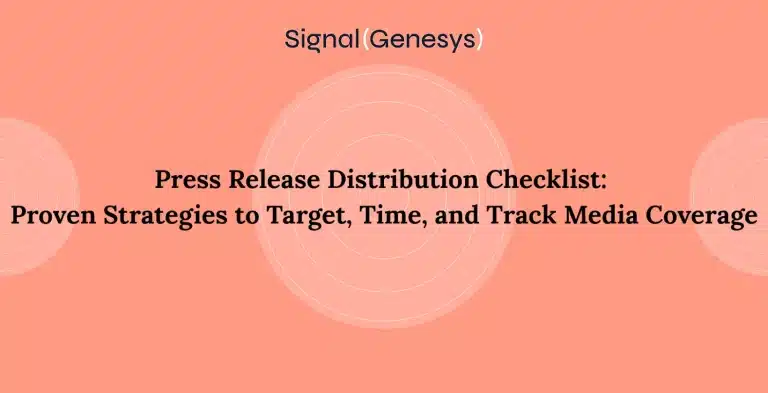A press release distribution checklist serves as the blueprint for securing consistent and impactful media coverage. A checklist transforms distribution from an unstructured outreach effort into a deliberate process that combines precision targeting, strategic timing, and data-driven tracking. Targeting focuses on identifying journalists, editors, and media outlets whose coverage aligns directly with the story, ensuring every contact receives relevant content.
Timing is the factor that determines whether a story gets noticed or buried. Aligning distribution with newsroom cycles, publication deadlines, and industry trends maximizes visibility, while avoiding conflicts with major news events prevents the release from being overshadowed. Tracking closes the loop by providing measurable insights into how a release performs once it is published. Analytics tools reveal which outlets picked up the story, how readers engaged with it, and which distribution channels delivered the strongest results.
Without a checklist, press release distribution becomes inconsistent, reactive, and ineffective. Stories are sent to irrelevant contacts, important deadlines are missed, and coverage opportunities are lost. This article delivers a clear framework for identifying the right media targets, scheduling releases for maximum impact, and tracking outcomes to refine future strategies. This article will equip you with proven methods to reach the right audience, at the right time, with measurable results.
How to Distribute a Press Release?
To distribute a press release effectively, establish a clear foundation before drafting the content. Define the purpose of the announcement, align it with organizational goals, and research the market context to ensure the story holds genuine news value. Analyze audience demographics, industry trends, and competitor activity to identify unique angles that elevate the release above generic announcements.
Build a comprehensive media list that reflects both reach and relevance, ensuring each contact aligns with the press release’s subject matter. Prepare multimedia assets, supporting data, and compelling quotes in advance to strengthen editorial appeal and increase the likelihood of media coverage.
The steps to distributing a press release are detailed below.
Identify the Target Audience
A press release achieves maximum impact when written for a precisely defined audience segment. Targeting begins with segmenting the market based on industry, geography, organizational role, and level of decision-making authority. Identifying the audience early shapes every subsequent decision, from language and tone to distribution channels and supporting assets. Precision targeting ensures that the release is acted upon by the right people.
Industry relevance requires an analysis of which segments actively seek the type of information being announced. This involves moving beyond broad categories and focusing on micro-segments that influence purchasing decisions or public perception. For example, a healthcare technology announcement resonates more strongly with hospital procurement managers than general healthcare readers. Pinpointing these micro-segments increases the likelihood of direct engagement.
Understanding audience pain points elevates the release from informational to actionable. Researching industry challenges, current debates, and regulatory shifts allows you to frame the announcement as a solution or valuable contribution. Audiences engage more readily with content that directly addresses their needs or professional objectives. This relevance is established through competitive research, customer surveys, or analyzing trending industry discussions.
Audience analysis is not a one-time step. As industries evolve and market behavior shifts, the profile of an ideal audience will also change. Maintaining updated buyer personas and regularly revisiting distribution priorities keeps press release campaigns aligned with current realities.
Select Distribution Partners
Distribution partners determine the scale, speed, and precision of your press release’s reach. A strong partner brings established media relationships, robust syndication networks, and the ability to match content with relevant outlets. This selection process starts with evaluating partners for their industry specialization. A platform deeply embedded in your niche will outperform generalist networks when the goal is targeted visibility.
Evaluating geographic reach is critical. Some partners excel in regional markets, which is essential for local announcements like event launches or municipal projects. Others maintain global syndication, making them ideal for product launches with international potential. Matching distribution scale to the intended audience ensures that resources are invested in relevant coverage rather than unfocused exposure.
Technology integration is another differentiating factor. The most effective distribution services provide analytics dashboards, campaign performance tracking, and CRM integrations. This data allows for real-time adjustments and post-distribution evaluation, turning each release into a measurable asset. Partners that lack transparent performance reporting make it harder to assess ROI.
The right distribution partners align with your brand’s positioning. Some networks cater to premium-tier announcements and expect high production quality, while others focus on rapid, high-volume distribution. Choosing a partner whose audience and tone match your brand ensures consistency across all communication touchpoints.
Develop a Personalized Outreach Strategy
A personalized outreach strategy ensures media contacts receive tailored information that aligns with their coverage interests and audience. Research each journalist’s previous articles, preferred topics, and editorial style before making contact. Reference recent work or relevant beats in your outreach to demonstrate that the release aligns with their reporting needs. Use precise subject lines and opening sentences to signal relevance immediately. Tailoring the tone, format, and framing of your pitch increases engagement and builds credibility with media professionals.
Segment contacts into categories based on publication type, readership profile, or geographic focus. Craft variations of the release or pitch for each segment to improve resonance. Avoid generic mass emails, as journalists prioritize exclusive or well-matched content. This level of customization positions your release as a valuable resource rather than unsolicited material.
Leverage multimedia in the outreach where relevant, attaching high-resolution images, short video clips, or infographics that strengthen the story angle. Visual assets make the release easier to envision as a published piece and can increase pick-up rates. Keep files lightweight or provide secure links for download to maintain accessibility.
Record outreach efforts in a centralized database or CRM to track which contacts respond, which requests require follow-up, and which relationships hold long-term potential. Over time, this data builds a network of media partners with a proven interest in your organization’s news.
Schedule Press Release Distribution Strategically
Strategic scheduling maximizes the visibility and engagement potential of your press release. Analyze your target audience’s content consumption patterns to determine the optimal time for release. For example, trade media may prefer early weekday mornings, while consumer-focused outlets might favor late afternoons for digital audiences. Avoid peak news cycles dominated by unrelated breaking stories to prevent your release from being buried.
Coordinate timing with key events in your industry or organization. Aligning the release with product launches, conferences, or regulatory updates enhances its relevance and timeliness. Use editorial calendars from major outlets to identify coverage windows where your story fits seamlessly.
Implement regional timing strategies when targeting multiple time zones. Send the release to each region at the start of their workday to increase the likelihood of review. This staggered approach preserves freshness and reduces competition within each market.
Integrate your schedule with internal communications and marketing activities. Ensure that supporting campaigns, such as social media promotion or email announcements, launch simultaneously to create a unified amplification effect. Document the results to refine future timing strategies.
Follow Up with Media Contacts
Following up with media contacts reinforces the initial outreach and keeps your story top of mind. Timing follow-ups within 48–72 hours of initial distribution ensures the release remains relevant while allowing enough time for review. Personalize follow-up messages by referencing the recipient’s beat and potential story angles that align with their audience.
Avoid generic reminders and instead offer additional value, such as new statistics, expert commentary, or updated visuals that enhance the original announcement. This approach positions the follow-up as an extension of the initial pitch rather than a repetitive nudge.
Track journalist engagement by monitoring email opens, link clicks, and social interactions to determine which contacts require a follow-up and how to adjust messaging. These insights allow you to prioritize high-potential leads while refining future outreach efforts.
Maintain a courteous, professional tone that acknowledges the journalist’s time and workload. Building rapport over multiple campaigns strengthens media relationships and increases the likelihood of future coverage.
Distribute Across Owned Media Channels
Owned media channels expand distribution beyond third-party outlets and create direct audience touchpoints. Publishing the press release on your company website provides a permanent, shareable link for journalists, stakeholders, and customers. Optimize the page for search visibility by incorporating relevant keywords, metadata, and schema markup.
Leverage social media platforms to amplify reach, tailoring post formats to suit each channel’s audience behavior. Include visual elements such as infographics, video clips, or behind-the-scenes images to boost engagement. Tagging relevant journalists, partners, or influencers can further increase visibility and encourage sharing.
Email newsletters offer another high-value owned channel for reaching subscribers already interested in your brand. Segment lists to deliver the release to the most relevant audience groups and highlight the key news angle in the subject line.
Integrating the release into other brand content, such as blog posts, podcasts, or webinars, extends its shelf life and allows deeper exploration of the story. Cross-channel consistency ensures the message remains clear and authoritative across all touchpoints.
Track and Measure Results
Tracking results validates the effectiveness of the distribution strategy and informs future improvements. Monitor media mentions across online, print, and broadcast channels to measure pickup and assess story resonance. Include sentiment analysis to understand how the coverage aligns with brand positioning.
Measure social media activity by tracking post reach, engagement rates, and referral traffic generated by the release. Identify which platforms produce the strongest amplification and adjust future distribution efforts accordingly.
Analyze conversion data to evaluate the press release’s impact on measurable business outcomes, such as lead generation, event registrations, or product inquiries. Integrating analytics tools allows for precise attribution of conversions to specific distribution channels.
Compile all findings into a post-campaign report that compares performance against defined KPIs. Use this data to refine targeting, adjust scheduling, and improve outreach strategies, ensuring each subsequent release achieves stronger results.





